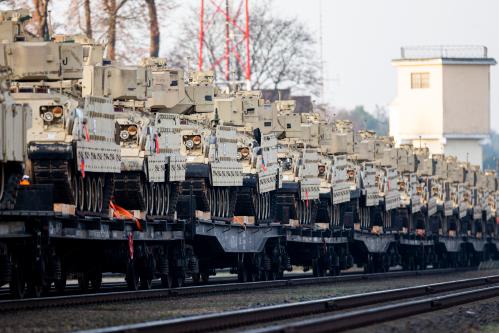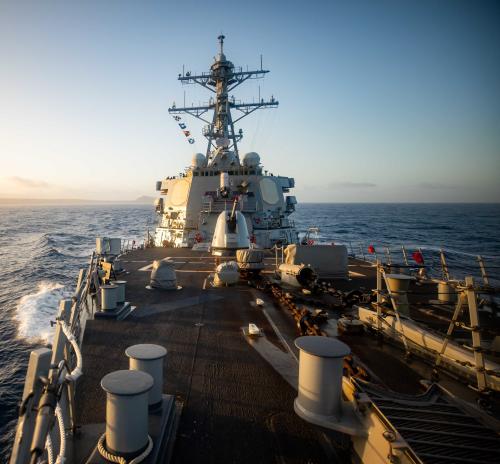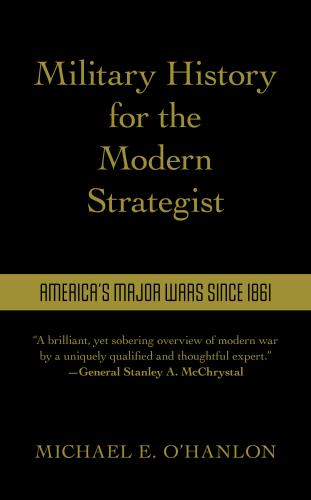Executive summary
Logistics do not fit prominently into any of the military identities that Carl Builder, the famous RAND author, described for each of the nation’s three largest services in his masterful 1989 book, “Masks of War.” The Air Force prioritizes high technology. The Navy cherishes autonomy and thus the forward-deployed combat ships. The Army understands that it has many roles, but it still glorifies the great fights of World War II. By contrast, transports and tankers, refueling hubs and maintenance hangars, and the computers that link them all into a single network are often regrettably forgotten — even by the very generals and admirals who, according to the adage, supposedly think about them constantly. Since those fancy weapons and combat formations cannot function without logistics, that is a big problem. Since logistics in today’s world would be contested by the adversary in any high-end war against Russia or China, the penalty for undervaluing logistics could be even greater than before.
In the modern American defense debate, with its emphasis on great power competition and, most specifically, the deterrence of China, a number of military capabilities are getting lots of attention. They include hypersonic missiles, artificial intelligence, precision munitions, long-range stealth bombers, and submarines. Less sexy, but just as crucial are military logistics — the systems that deploy forces around the world and supply them with the water, fuel, ammunition, food, spare parts, medical care, and other essentials needed to make them effective in combat. If the United States fights China in the Western Pacific, the Chinese can fight from “home station.” That advantage drastically reduces their logistics challenges relative to those faced by the United States (though if the United States can transform the conflict into a broader regional fight over control of the sea lines of communication, the challenges faced by the two sides may be comparable). We need to make the logistics triad — transport systems, physical military infrastructure, and digital/cyber infrastructure tying everything together — a top priority in our defense modernization efforts as well.
Introduction
Logistics tend to be the ugly ducklings of America’s modern military. They do not fit prominently into any of the military identities that Carl Builder, the famous RAND author, described for each of the nation’s three largest services in his masterful 1989 book, “Masks of War.” The Air Force prioritizes high technology. The Navy cherishes autonomy and thus the forward-deployed combat ships. The Army understands that it has many roles, but it still glorifies the great fights of World War II. By contrast, transports and tankers, refueling hubs and maintenance hangars, and the computers that link them all into a single network are often regrettably forgotten — even by the very generals and admirals who, according to the adage, supposedly think about them constantly. Since those fancy weapons and combat formations cannot function without logistics, that is a big problem. Since logistics in today’s world would be contested by the adversary in any high-end war against Russia or China, the penalty for undervaluing logistics could be even greater than before.
It has not always been so. Logistics were prioritized in the world wars, for example, in the famous “Battle of the Atlantic” as well as the great island-hopping campaigns of the Pacific theater. They also had a golden moment in the 1980s. After the Soviet invasion of Afghanistan in 1979, leading to the creation of the Rapid Deployment Force, as well as the failed Iran hostage rescue mission of 1980 and the ensuing Goldwater-Nichols legislation of 1986, the nation realized it might have to fight in a different geographic theater than previously expected. Central Command and Transportation Command were created in the 1980s. The logistics enterprise benefited enormously. The Reagan administration’s defense buildup funded ferry ships, C-17 aircraft, refuelers, and tankers. It also resourced base infrastructure in places like Saudi Arabia that were designed to receive all those ships and planes. And what the Pentagon forgot to request, Congress remembered to provide, such as Oshkosh transport trucks that House Armed Services Committee Chairman Les Aspin added to defense authorization bills on both parochial and strategic grounds. All these innovations were vindicated after Iraq invaded Kuwait in 1990 and U.S. forces came quickly to the rescue; base networks in the broader Middle East region were further enhanced during the “forever wars” of the 2000s and 2010s.
Three problematic trends for U.S. logistics
But as time has gone by, and America’s strategic center of gravity has shifted to the Western Pacific, three problematic trends have weakened American logistics capabilities. First, ships and planes (and trucks) bought in the 1980s have aged and atrophied, without being adequately maintained or replaced. Second, China (and Russia) has developed precision missiles that can threaten fixed bases anywhere, especially in regions near its shores. Three, cyber systems have proliferated. That has made logistics more efficient, but it has also created new vulnerabilities for America’s global transport and supply networks.
The Ukraine war has not highlighted these weaknesses because we have lots of allies in Europe near Ukraine and because Russia has not dared to attack NATO logistics networks. The situation would almost surely be much different, however, in a war against China. To deter that war, we need to address these challenges with sustained attention to each element of the logistics triad — transport vessels, including ships and planes; infrastructure, including major logistics hubs in forward theaters; and the digital command and control system that makes the constellation of global capabilities work as a single whole.
Protecting the logistics muscle from atrophy
Distribution assets such as ships and aircraft are the “muscles” of any logistic network and are especially critical in the Western Pacific. With the vast distances involved, movement by air is the only realistic method of quickly transporting critical cargo and personnel. The United States maintains a fleet of some of the best military cargo aircraft in the world, but it is aging and perennially vexed by chronic readiness issues (the C-17 did not meet its mission-capable readiness goal once during an 11-year time span) driven by a diminishing manufacturing base, repair part shortages, and delays during major overhauls.1
On the other hand, the geography and nature of the maritime environment dictate that most lift requirements are filled by ship. This has remained remarkably constant. During the height of the Vietnam War, sealift accounted for 96% of all cargo movement.2 Twenty years later, during Operation Desert Shield-Desert Storm, it was 94.4%.3 Yet our strategic sealift capability, fundamental to U.S. power projection and military strategy, suffers from the same afflictions as our airlift fleet. Maintenance issues stemming from an increasingly anemic industrial base are on the rise, limiting availability. The average age of the surge sealift fleet is 40 years, meaning as ships reach the end of their 50-to-55-year service life over the next decade, the overall sealift capacity is projected to drop precipitously, from 11 million square feet to less than 3 million square feet by 2035.4 As a very simple reference point, 1 million square feet of shipping space will move about 70% of the equipment used by a single Marine Corps Expeditionary Brigade of around 16,000 personnel.5 Purchasing enough capacity to stay around 11 million square feet could, depending on ship type (e.g., roll-on/roll-off vessels versus amphibious ships), cost $25 billion or more over a decade.6
Poor transportation asset availability rates and a lack of distribution capacity would not bode well in a shooting war with China, where we would inevitably suffer combat losses of these ships and aircraft. This could easily create a distribution network death spiral, where already strained assets are forced to surge even more, putting them at increased risk of maintenance issues and exposure to enemy threats. Simply, the United States needs to begin laying the foundations now to ensure the availability of the capacity required to prevail (and therefore, hopefully, deter) against China. This capacity could be realized through increased investments toward maintaining existing platforms, funding strategies that revitalize the industrial base, procurement of replacement platforms, or development of all-new platforms. Likely, a combination of all these strategies will be necessary to ensure the logistics “muscle” of the U.S. military does not further atrophy.
The vulnerability of physical infrastructure
The physical infrastructure undergirding military logistics includes a broad swath of government, military, and civilian facilities and assets. Air and seaports, roads, railways, electrical grids, and the like all tie into bases to support the generation, deployment, and sustainment of military forces. Military bases are located at or near critical logistics nodes, often sharing facilities such as runways or pier space with civilian entities. This is especially true in the Western Pacific, where geographic isolation and all its challenges are ubiquitous. Military and industrial installations on islands are closely integrated with and reliant on the life support networks, such as power and water, that support all island inhabitants. Given this, our military physical infrastructure in the Western Pacific is extremely vulnerable to disruption by cyber and/or physical attacks.
Indeed, of the three parts of our triad, physical infrastructure may represent the best “return on investment” for an adversary, such as China, to attack. Facilities like military bases, ports, and airfields are easy to target. They are stationary and difficult to hide, requiring relatively little effort to maintain accurate targeting data. A savvy opponent also knows that a massive, precision-munition-draining bombardment may not be required. Modern industrial and military facilities are complicated and designed to support and service similarly technologically complex platforms such as modern military aircraft and naval shipping. So, targeting selected critical components of a facility, such as power substations, cargo handling cranes, or runways, is often enough to take that facility offline. Moreover, a U.S. adversary could further economize its attacks by targeting a critical hub location such as Guam, where multiple types of facilities and infrastructure are located. Suddenly, ships and aircraft with personnel and materiel destined for multiple locations further into the fight cannot depart, and a similar flow arriving from multiple locations has nowhere to arrive. Simultaneously knocking out or degrading multiple infrastructure assets at a key hub location sends logistics shockwaves in all directions of a supply chain or web.
The sense of physical infrastructure vulnerability being an Achilles’ Heel makes it tempting to identify and implement any concepts that either promise to lessen dependence on fixed, physical sites or to eliminate the vulnerability through a robust defensive scheme. To be sure, any concept(s) that reduce logistic support demands are worthy of further research and development, but it is extremely doubtful that the immense resource appetite of the U.S. military will be abated in such a way as to obviate its reliance on infrastructure. Military vehicles are heavy, large, and thirsty for fuel; command and control technologies are power intensive; and the most powerful and useful munitions are invariably large and difficult to handle, requiring specialized equipment. Similarly, we must have more and better missile defense technology, but it is unrealistic to assume defensive measures will be 100% effective 100% of the time.
We are, and will be, reliant on vulnerable physical infrastructure to project and sustain forces in a future conflict. We should expect it to be attacked, and we should expect it to be damaged or even destroyed. Having hardened and distributed infrastructure is important, but it must be balanced; infrastructure does not come cheap. The costs of relocating approximately 5,000 Marines from Okinawa to Guam, much of it construction costs, have been estimated to be around $8.7 billion in 2012 dollars (approximately $11.7 billion today), while the relocation of the Marines’ air station on Okinawa from Futenma to Camp Schwab is estimated to cost $22.7 billion.7 Replacing a single pier at a naval station costs around $15 million, and the first phase of airfield development in Tinian is scheduled to cost $58 million.8 Yet high-dollar construction projects do not have to be the single solution. Congress could take steps to authorize the Department of Defense (DOD) and local commanders to utilize current-year operations and maintenance funding for certain lower-cost projects, including projects in allied or partner countries. In many cases, the ability to access money quickly to enact repairs or improvements now can be more effective than entering the laborious, multi-year military construction process.
Building and upgrading our infrastructure to be modern and survivable is critical, and planning toward resiliency must be equally as important. The heroic efforts of the Ukrainians to repair their electrical grids after repeated Russian attacks demonstrated that while infrastructure may be easy to target, it can be made hard to kill. The prepositioning of seemingly mundane items such as concrete, cement, electrical power transformers, wiring and piping, generators, and construction equipment would lessen repair times after the attack. Expedient and temporary solutions, such as floating piers, could play a major role in keeping sustainment flowing to and from the fight and mitigating downstream logistics shocks to combat units.
Improving digital logistic systems
The DOD digital logistic systems (DLS) manage inventory, place orders, and track shipments to move personnel, weapons systems, and support equipment globally. Unfortunately, DOD has increased risk with multiple legacy logistic systems and with a tendency to transmit over multiple unsecured Non-classified Internet Protocol Router Network (NIPRNet) systems.
Every U.S. military department or service has developed a separate logistics enterprise resource planning (ERP) software, resulting in six major systems.9 The number is much larger still when one counts the multiple subcomponent and feeder systems providing data to the ERPs. China consolidated its military logistics into one logistic force in 2016 called the Joint Logistics Support Force.10 This move eliminated the large self-contained logistic systems for each service. That is the right approach.
The current DLS processes require a request from one location transmitted over communication networks, including undersea cables, satellites, and NIPRNet, into stove-piped central databases. This process provides vulnerabilities open to exploitation, as reported by Microsoft in May 2023 concerning cyber espionage against critical transportation and communication infrastructure in Guam.11 Understanding how challenges manifest and execute in a DLS is critical to mitigating vulnerabilities. The DOD can appoint U.S. Transportation Command or the Defense Logistics Agency as an executive agent to have a single ERP for the department. The executive agent’s authority would encompass converting DOD to one mandated ERP system, maintaining security, and integrating new technology.12 The DOD executive agent implementing a single cloud-based ERP would enable accelerated onboarding of new technology and provide redundancies as well as resilience. Effective ERP protocols could be enacted to secure data when transmitting and receiving in an intermittent cyber environment. Adding in the utilization of artificial intelligence and machine learning to detect intrusions, take predetermined logistic actions, and conduct analytics would further harden the system against attack. Finally, the implementation of financial and requisition data using blockchain structures, as currently done commercially, would revitalize this leg of the logistics triad now and in the future.
Conclusion
There are no magic answers or silver bullets when improving this nation’s ability to move, supply, and sustain its armed forces abroad. Also, Russia’s ineffectual aggression against Ukraine has demonstrated that even close proximity of massive supplies to a conflict cannot overcome inept logistics. Thus, the triad of military logistics systems must be seen as an ongoing top priority for DOD, up there with the nuclear triad, command and control, fighters and bombers, tanks and rockets, and subs and ships. A global military power has no choice in the modern era.
-
Acknowledgements and disclosures
The authors would like to thank Adam Lammon for editing and Rachel Slattery for layout.
-
Footnotes
- Diana Maurer, “Military Readiness: Improvement in Some Areas, But Sustainment and Other Challenges Persist,” Testimony before the U.S. Senate Subcommittee on Readiness and Management Support, Committee on Armed Services, May 2, 2023, 8-9, https://www.gao.gov/assets/gao-23-106673.pdf.
- Charles R. Shrader, United States Army Logistics, 1775-1992: An Anthology, Vol. 3 (Washington, DC: Center of Military History, 1997), 694, https://history.army.mil/html/books/068/68-3/cmhPub_68-3.pdf.
- James K. Matthews and Cora J. Holt, So Many, So Much, So Far, So Fast: United States Transportation Command and Strategic Deployment for Operation Desert Shield/Desert Storm (Washington, DC: Office of the Chairman of the Joint Chiefs of Staff and Research Center United States Transportation Command, 1996), 13, https://www.jcs.mil/Portals/36/Documents/History/Monographs/Transcom.pdf.
- “Navy Readiness: Action Needed to Maintain Viable Surge Sealift and Combat Logistics Fleets,” (Washington, DC: Government Accountability Office, 2017), 11-18, https://www.gao.gov/assets/gao-17-503.pdf.
- “Prepositioning Programs Handbook,” (Washington, DC: Headquarters Marine Corps, 3rd Edition, 2015), A-4, https://www.marines.mil/portals/1/Publications/PrepositioningHandbook_3dEdition.pdf?ver=2016-11-23-091649-367.
- Michael E. O’Hanlon, Defense 101: Understanding the Military of Today and Tomorrow (Ithaca, NY: Cornell University Press, 2021), 40-42, 74-80.
- Emma Chanlett-Avery, Christopher T. Mann, and Joshua A. Williams, “U.S. Military Presence on Okinawa and Realignment to Guam, (Washington, DC: Congressional Research Service, 2019), 2, https://apps.dtic.mil/sti/pdfs/AD1170032.pdf.
- “Construction Programs (C-1),” Department of Defense Budget Fiscal Year 2023 (Washington, DC: Department of Defense, April 2022), https://comptroller.defense.gov/Portals/45/Documents/defbudget/FY2023/FY2023_c1.pdf.
- “What is ERP,” accessed March 23, 2023, https://www.sap.com/products/erp/what-is-erp.html#:~:text=Enterprise%20resource%20planning%20(ERP)%20is,services%2C%20procurement%2C%20and%20more.
- Minnie Chan, “Chinese media unveils details of US-inspired military logistics system,” South China Morning Post, May 11, 2022, https://www.scmp.com/news/china/military/article/3177222/chinese-media-unveils-details-us-inspired-military-logistics.
- Zeba Siddiqui and Christopher Bing, “Chinese hackers spying on U.S. critical infrastructure, Western intelligence says,” Reuters, May 24, 2023, https://www.reuters.com/technology/microsoft-says-china-backed-hacker-targeted-critical-us-infrastructure-2023-05-24/.
- Jaspreet Gill, “Zero Trust is the Pentagon’s new cyber buzzword. It might not have stopped the Discord leaks.,” Breaking Defense, April 24, 2023, https://breakingdefense.com/2023/04/zero-trust-is-the-pentagons-new-cyber-buzzword-it-might-not-have-stopped-the-discord-leaks/?utm_campaign=dfn-ebb&utm_medium=email&utm_source=sailthru&SToverlay=2002c2d9-c344-4bbb-8610-e5794efcfa7d.
The Brookings Institution is committed to quality, independence, and impact.
We are supported by a diverse array of funders. In line with our values and policies, each Brookings publication represents the sole views of its author(s).











